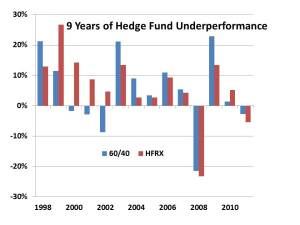Another Disappointing Year for Hedge Funds
2002 seems like a long time ago, but that’s the last time hedge funds outperformed a simple blend of 60% stocks and 40% bonds. Through 2000-02 during the dot-com collapse hedge funds added value, but since then as assets have flowed in the weight of all that money has steadily dragged down returns. Following a torrid performance in September, the HFRI Fund Weighted Index (HFRX) is down 5% for the year, compared with 3% for a simple 60/40 blend. No doubt much of the selling in September was caused by the over-leveraged becoming less so with urgency – the frantic buying of October looks like its mirror image. It’s looking increasingly as if this will be the 9th straight year in which old-fashioned investing without the use of absolute return vehicles has outperformed the more modern variety.
Part of the problem lies in how some of the biggest funds have done. To take John Paulson as an example: he began the year with $38 billion in assets under management (AUM), around 2% of the entire industry. If he’s down around 40% on average across all his funds, that represents almost a 1% performance hit to the beleagured community of hedge fund investors. Given what appears to be modest return expectations among institutions of only 6-7%, that’s a chunk of performance to be made up by the rest of the industry since Paulson has on his own knocked almost 1% off aggregate 2011 returns.
